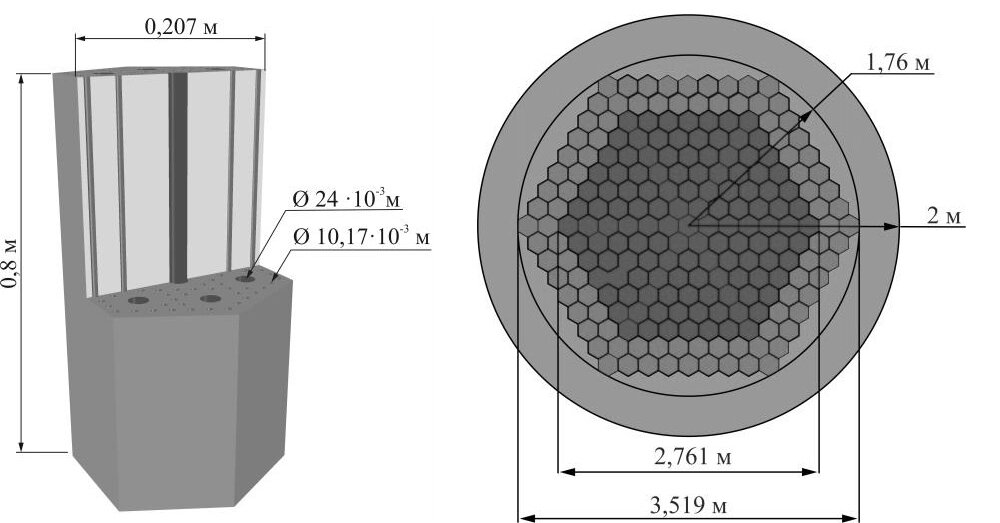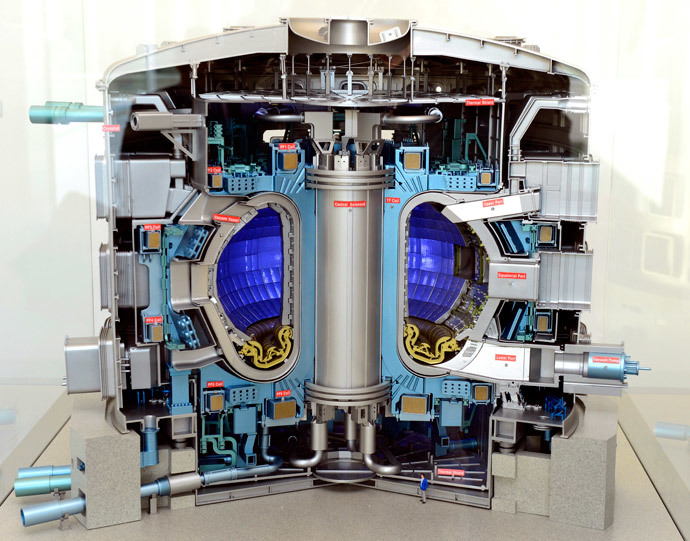RT.com Dispatches
JANUARY 29, 2020
Scientists develop a concept of a hybrid thorium reactor
Russian scientists have proposed a concept of a thorium hybrid reactor that obtains additional neutrons using high-temperature plasma held in a long magnetic trap. This project was applied in close collaboration between Tomsk Polytechnic University, All-Russian Scientific Research Institute Of Technical Physics (VNIITF), and Budker Institute of Nuclear Physics of SB RAS. The proposed thorium hybrid reactor is distinguished from today's nuclear reactors by moderate power, relatively compact size, high operational safety, and a low level of radioactive waste.
Precursor articles—
First published on 15 Oct, 2014 (Updated 6 years ago)

The view of the Kurchatov Institute National Research Center, Moscow.(RIA Novosti / Alexey Kudenko) © RIA Novosti
A hybrid nuclear reactor is a sort of stepping stone to building a true nuclear fusion reactor. It uses a fusion reaction as a source of neutrons to initiate a fission reaction in a ‘blanket’ of traditional nuclear fuel.
The approach has a number of potential benefits in terms of safety, non-proliferation and cost of generated energy, and Russia is developing such a hybrid reactor, according to Mikhail Kovalchuk, director of the Kurchatov Research Center.
“Today we have started the realization of a distinctively new project. We are trying to combine a schematically operational nuclear plant reactor with a ‘tokamak’ to create a hybrid reactor,” he told RIA Novosti, referring to a type of fusion reactor design.
“This project is open for our colleagues, the Chinese in the first place. It's being discussed,” he added.
Being a leading producer in civilian nuclear energy industry, Russia would benefit from improving its plant designs. A hybrid fusion-fission reactor may be several times more efficient than a traditional fission reactor. And building one is “a goal for tomorrow” rather than the distant future, as is the case for a fusion reactor like the famous France-based International Thermonuclear Experimental Reactor (ITER) that Russia collaborates on, Kovalchuk said.
Harnessing nuclear fusion for energy generation has been elusive for years. So far no industrial-scale design managed to produce more energy than it consumes to start the reaction, though the California-based National Ignition Facility (NIF) was reported to have achieved this goal on lab-scale by bombarding a fuel pellet with 192 powerful lasers.
READ: Nuclear fusion breakthrough: US scientists make crucial step to limitless power
But nuclear fusion produces neutrons, and those can initiate fission in traditional nuclear fuel like uranium or plutonium. In a hybrid reactor the core fusion zone consumes energy to heat up outer fissile blanket, which on its part generates energy.
A hybrid reactor plant would likely be even more costly that regular nuclear power plants are, considering the complexities of the design. But it is inherently safer, since the reaction in the fissile blanket would be sub-critical, that is, it won't sustain itself. In an emergency it could be simply stopped in a matter of seconds by turning off the fusion core, as opposed to using dampening rods in a traditional reactor.
Another benefit of a hybrid design is that it ‘burns down’ fissile materials leaving little by-products. So it won't produce radioactive waste and can even treat spent nuclear fuel from regular reactors.
Rather than taking NIF's pellet-and-lasers design for the fusion reactor, Russia wants to use a tokamak, a reactor that suspends superheated plasma with powerful magnetic fields, as the core of a hybrid reactor. ITER uses the design too.
A similar tokamak-based project of a hybrid fusion-fission nuclear reactor is being developed at the University of Texas at Austin, although researchers there eye nuclear waste disposal rather than electricity generation as the goal.
Nuclear fusion breakthrough: US scientists make crucial step to limitless power
Researchers at the federally-funded Lawrence Livermore National Laboratory revealed in a study released Wednesday in the peer-reviewed journal Nature that, for the first time, one of their experiments has yielded more energy out of fusion than was used in the fuel that created the reaction.
In a 10-story building the size of three football fields, the Livermore scientists “used 192 lasers to compress a pellet of fuel and generate a reaction in which more energy came out of the fuel core than went into it,” wrote the Washington Post. “Ignition” would mean more energy was produced than was used in the entire process.
"We're closer than anyone's gotten before," said Omar Hurricane, a physicist at Livermore and lead author of the study. "It does show there's promise."
The process ultimately mimics the processes in the core of a star inside the laboratory’s hardware. Nuclear fusion, which is how the sun is heated, creates energy when atomic nuclei fuse and form a larger atom.
"This isn't like building a bridge," Hurricane told USA Today in an interview. "This is an exceedingly hard problem. You're basically trying to produce a star, on a small scale, here on Earth."
A fusion reactor would operate on a common form of hydrogen found in sea water and create minimal nuclear waste while not being nearly as volatile as a traditional nuclear-fission reactor. Fission, used in nuclear power plants, works by splitting atoms.
Hurricane said he does not know how long it will take to reach that point, where fusion is a viable energy source.
"Picture yourself halfway up a mountain, but the mountain is covered in clouds," he told reporters on a conference call Wednesday. “And then someone calls you on your satellite phone and asks you, ‘How long is it going to take you to climb to the top of the mountain?’ You just don’t know.”
The beams of the 192 lasers Livermore used can pinpoint extreme amounts of energy in billionth-of-a-second pulses on any target. Hurricane said the energy produced by the process was about twice the amount that was in the fuel of the plastic-capsule target. Though the amount of energy yielded equaled only around 1 percent of energy delivered by the lasers to the capsule to ignite the process.
“When briefly compressed by the laser pulses, the isotopes fused, generating new particles and heating up the fuel further and generating still more nuclear reactions, particles and heat,” wrote the Washington Post, adding that the feedback mechanism is known as “alpha heating.”
Debbie Callahan, co-author of the study, said the capsule had to be compressed 35 times to start the reaction, “akin to compressing a basketball to the size of a pea,” according to USA Today.
While applauding the Livermore team’s findings, fusion experts added researchers have “a factor of about 100 to go.”
"These results are still a long way from ignition, but they represent a significant step forward in fusion research," said Mark Herrmann of the Sandia National Laboratories' Pulsed Power Sciences Center. "Achieving pressures this large, even for vanishingly short times, is no easy task."
Livermore is the site of the multi-billion-dollar National Ignition Facility, funded by the National Nuclear Security Administration. Fusion experiments aren’t the only function of the lab; for example, it also studies the processes of nuclear weapon explosions.
Long-pursued by scientists dating back to Albert Einstein, fusion energy does not emit greenhouse gases or leave behind radioactive waste. Since the 1940s, researchers have employed magnetic fields to contain high-temperature hydrogen fuel. Laser use began in the 1970s.
"We have waited 60 years to get close to controlled fusion," said, Steve Cowley, of the United Kingdom's Culham Center for Fusion Energy. He added scientists are "now close"with both magnets and lasers. "We must keep at it."
Stewart Prager - director of the Princeton Plasma Physics Laboratory, which studies fusion using magnets - told the Post he was optimistic about fusion energy’s future.
“In 30 years, we’ll have electricity on the grid produced by fusion energy – absolutely,”Prager said. “I think the open questions now are how complicated a system will it be, how expensive it will be, how economically attractive it will be.”
[premium_newsticker id="211406"]
The views expressed are solely those of the author and may or may not reflect those of The Greanville Post
YOU ARE FREE TO REPRODUCE THIS ARTICLE PROVIDED YOU GIVE PROPER CREDIT TO THE GREANVILLE POST
VIA A BACK LIVE LINK.






